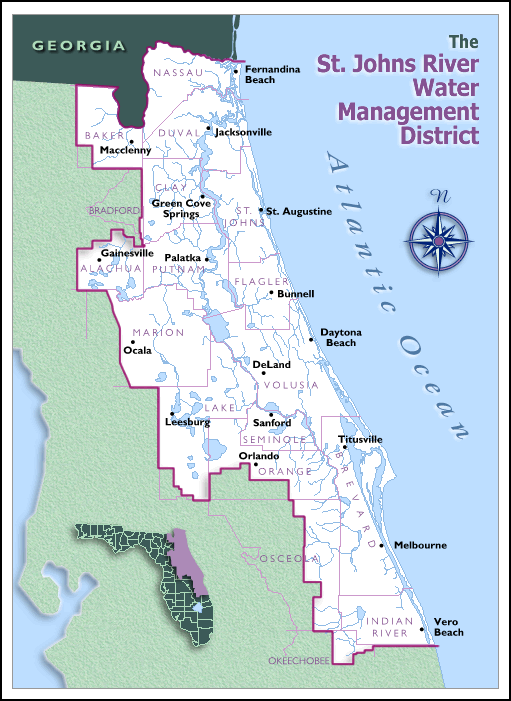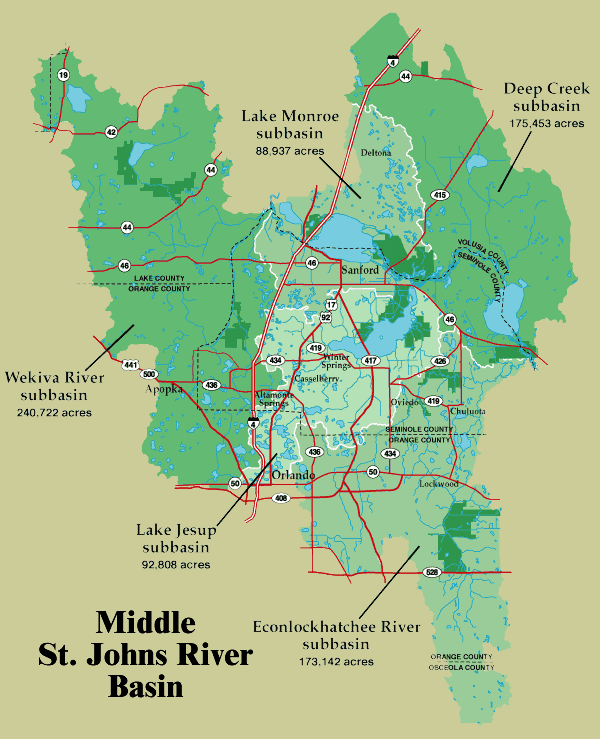2005
The Watershed Action Volunteer (WAV) Program worked with 40 public and private agencies to fund programs in 14 of the 18 counties in the St. Johns River Water Management District’s service area. Hundreds of volunteers in those counties donated nearly 25,000 hours to diverse activities, including educational programs in schools, water quality monitoring, invasive plant removal, neighborhood cleanups and adult education programs.
Dec. 13, 2005
The District’s Governing Board votes to amend the water conservation provisions in District rules, limiting lawn and landscape irrigation to no more than two days a week. The rule continues to prohibit irrigation between 10 a.m. and 4 p.m., which has been in place since May 1991. The limitation on the number of days for irrigation becomes effective March 1, 2006.
December 2005
The District completed construction of a sediment containment area in Micco this month. This is the site where “muck” dredged from the Sebastian River will be deposited. At an estimated 2 million cubic yards, this will be the largest dredging project of an Indian River Lagoon tributary to date.
Oct. 18, 2005
Students from Landrum Middle School in St. Johns County, who participate in the District’s Legacy Program, join students from around the world by participating in World Water Monitoring Day. The students took water samples from various sites near their school and posted results for the water’s temperature, acidity, dissolved oxygen and turbidity to the international website, where local results were compared with results from North and South America, Europe, Asia and the Middle East.

October 2005
“The River Returns,” a documentary about the St. Johns River, airs nationally on PBS. The District was the major sponsor of the film and District staff served as technical advisors for its scientific content. Through interviews with District staff and a tour of the 310-mile-long river, filmmaker Wes Skiles discusses the threats to the river, what the District and others are doing to restore it and what individuals can do to lessen their negative impacts on the waterway.
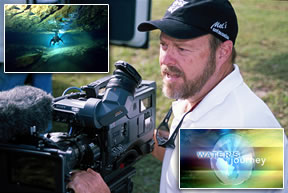
Filmmaker Wes Skiles prepares to film a segment of the “Water’s Journey — The River Returns” while on location in northeast Florida. The film includes underwater footage such as this cave diver exploring Mammoth Cave at Silver Springs (inset, upper left). At lower right inset is the logo seen on The River Returns and other films in the Water’s Journey series.
Summer 2005
Fourteen hurricanes form out of 27 named storms, making the 2005 hurricane season the busiest on record. Hurricane Epsilon was the last. It was named for a letter of the Greek alphabet after the National Weather Service ran through its alphabetized list of names.
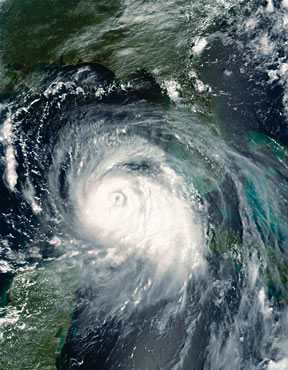
A NASA satellite image of Hurricane Katrina as the storm heads into the Gulf Coast. Florida is in the upper right side of the image.
Photo by NASA
Courtesy of Jeff Schmaltz,
MODIS Land Rapid Response Team
Early fall 2005
Greater than normal spring and early summer rainfall followed by dry, calm conditions and soaring temperatures provided ideal conditions for the growth of algae in various waterways. One persistent bloom in the lower St. Johns River Basin grew in clumps, causing large surface scums. During routine water sampling runs along the river, District field staff monitored the blooms that stretched from Lake George to Jacksonville. Algae experts identified microcystis aeruginosa, toxic blue-green algae, in the samples. Though blue-green algae is found in all waterways, some samples in the river’s lower basin exceeded World Health Organization recommended guidelines.
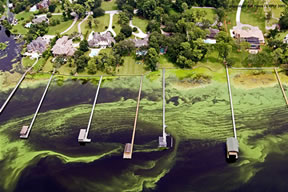
Water in the St. Johns River took on a sickly green tint during the summer and fall as algae fed on an abundance of nutrients in the water. Here, docks on the east side of the river at Mandarin reach into the bloom.
March 2005
The St. Johns River Water Management District and 19 water supply utility partners launched a mass media campaign focusing on watering lawns only up to two times a week, up to three-quarters of an inch per watering. StreamLines magazine cover with Tom MacCubbin, an environmental horticulturalist with the University of Florida’s Institute of Food and Agricultural Sciences and the Orange County Agricultural Extension Service, was featured in the campaign.
“My goal is to educate people on how to care for their lawns,” said MacCubbin. “Proper care includes irrigating up to two times a week in the dry season — less if it rains and in the fall and winter. I agreed to participate in the District’s educational efforts because our message is the same and we can reach more people with the message by working together.”

Feb. 23, 2005

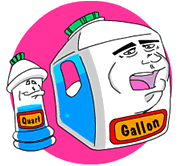 The third-grade version of a computer software program with various support materials for Florida educators is launched in a media event in schools in northeast and east-central Florida. Known as “The Great Water OdysseySM,” the software is an all-encompassing, fast-paced curriculum about water resources — all wrapped up in fun. The lessons teach about natural habitats, the water cycle and states of matter, focusing on history, geography, math, reading, social studies and science. “We believe it is important to begin to teach children at an early age about their role in the natural environment,” says Linda Burnette, director of the District’s Office of Communications and Governmental Affairs, at the launch. “Our interest in developing such a product is to inform the public about the importance of protecting water resources and to use those resources wisely, but the curricula are designed to meet general education requirements so that they are of use to educators.” District staff, contractors and educators continue to work on the fourth- and fifth-grade versions of the software.
The third-grade version of a computer software program with various support materials for Florida educators is launched in a media event in schools in northeast and east-central Florida. Known as “The Great Water OdysseySM,” the software is an all-encompassing, fast-paced curriculum about water resources — all wrapped up in fun. The lessons teach about natural habitats, the water cycle and states of matter, focusing on history, geography, math, reading, social studies and science. “We believe it is important to begin to teach children at an early age about their role in the natural environment,” says Linda Burnette, director of the District’s Office of Communications and Governmental Affairs, at the launch. “Our interest in developing such a product is to inform the public about the importance of protecting water resources and to use those resources wisely, but the curricula are designed to meet general education requirements so that they are of use to educators.” District staff, contractors and educators continue to work on the fourth- and fifth-grade versions of the software.
2004-2005
Legacy Water Resource Education programs took place or were begun in 18 schools in nine counties, incorporating lessons from more than 40 different career fields. The program generates more than 20,000 community service hours from students annually. It also nurtures the students to develop leadership skills and teaching abilities of their own while assisting agencies in achieving their recreational goals on public lands.
November 2004
The St. Johns River Water Management District launched the final phase of its E-Permitting initiative, allowing the public to search for permit statuses, receive notices, apply for well construction permits and contractor license renewals, pay application fees and file permit applications online.
October 2004
The St. Johns River Water Management District issued its first 30-year service award to Doug Munch, director of the Division of Groundwater Programs. Munch was one of the first employees hired by the District and he has spent his career in groundwater programs.
March 5, 2004
The St. Johns River Water Management District’s Governing Board Projects and Land Committee unveiled the first phase of the Lake Apopka Marsh Flow-Way. Area elected officials and environmental organizations that played an integral role in acquiring funding for the project toured the nearly 660-acre filtration system to get a firsthand look at how the flow-way functions. “To date, our calculations show that the flow-way has removed 334 tons of suspended solids,” says Gian Basili, program manager. “The removal of the suspended solids has contributed to improving the overall water quality of Lake Apopka.”
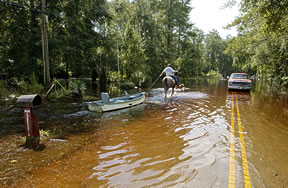
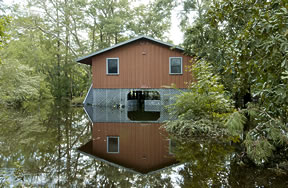
Low-lying areas along Black Creek in north Florida — and around similar areas near various water bodies — tend to flood during high rain events.

A portion of the roof at the District’s Palm Bay Service Center was ripped apart during Hurricane Jeanne in September 2004.
March 5, 2004
The St. Johns River Water Management District’s Governing Board Projects and Land Committee unveiled the first phase of the Lake Apopka Marsh Flow-Way. Area elected officials and environmental organizations that played an integral role in acquiring funding for the project toured the nearly 660-acre filtration system to get a firsthand look at how the flow-way functions. “To date, our calculations show that the flow-way has removed 334 tons of suspended solids,” says Gian Basili, program manager. “The removal of the suspended solids has contributed to improving the overall water quality of Lake Apopka.”
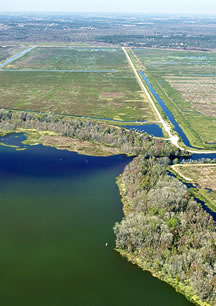
The marsh flow-way at Lake Apopka naturally removes pollutants from the lake’s water.
Feb. 11, 2004
The St. Johns River Water Management District held a public meeting to announce the results of the St. Johns River Water Supply Project. “The District is concluding a three-year study to determine the feasibility of using the St. Johns River as a potential water supply source to help meet future needs in east-central Florida,” said Alfred Canepa, assistant director of the District’s Department of Resource Management. “The results of the study are very encouraging. It is feasible to use the river as a source of supply, there are places that lend themselves to siting one or more treatment plants, and it can be done with only moderate impacts to rates paid by utility customers.”
2003
The St. Johns River Water Management District designated the Northern Coastal Basin and the Orange Creek Basin as SWIM program areas.
July 1, 2003
Water management District boundaries were redrawn. The part of Polk County in the St. Johns River Water Management District service area was transferred to the Southwest Florida Water Management District, leaving the St. Johns District with an 18-county service area.
2003
The St. Johns River Water Management District partnered with the city of Jacksonville, Florida Department of Environmental Protection (DEP) and other agencies to hold a riverwide St. Johns River Summit to establish a long-term management structure for carrying out comprehensive river restoration initiatives.
September 2001
The St. Johns River Water Management District moved its Orlando offices from downtown to Altamonte Springs.
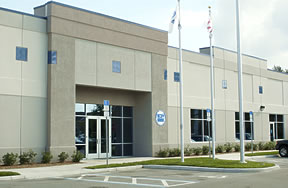
The District moved its east-central Florida office to Altamonte Springs to this facility in 2001.
July 11, 2001
Kirby Green was named executive director of the St. Johns River Water Management District.
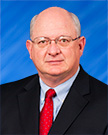
Kirby Green
2001
The St. Johns River Water Management District purchased the Edgefield property in the tri-county agricultural area in St. Johns County through the Florida Forever Land Acquisition Program, making it the District’s first Florida Forever purchase.
Jan. 10, 2001
The St. Johns River Water Management District issued a water shortage order for portions of Marion, Lake, Orange, Polk and Brevard counties and all of Seminole and Volusia counties.
June 2000
The St. Johns River Water Management District moved its Melbourne offices to its present combined location in Palm Bay. Nearly 100 employees made the move, including Mike Slayton, then director of the Office of Policy and Planning, named the District’s deputy executive director in 2001. “It’s a good utilitarian building to bring the public services all in one location,” said Slayton at the time.
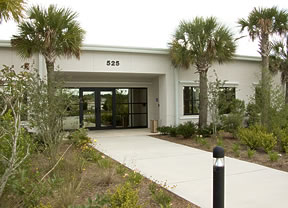
For the first time since establishing offices in the southern reach of the District, all the District’s staff were housed in one facility with the opening of the Palm Bay Service Center.
April 2000
The St. Johns River Water Management District published its first long-term water supply plan. Through the planning process — involving water suppliers, local governments and the public — the District identified areas where limits in sustainable groundwater withdrawals could be reached in the next 20 years.
2000
The St. Johns River Water Management District established a Middle St. Johns River Basin SWIM program.
2000
Florida’s population reached 15.98 million.


